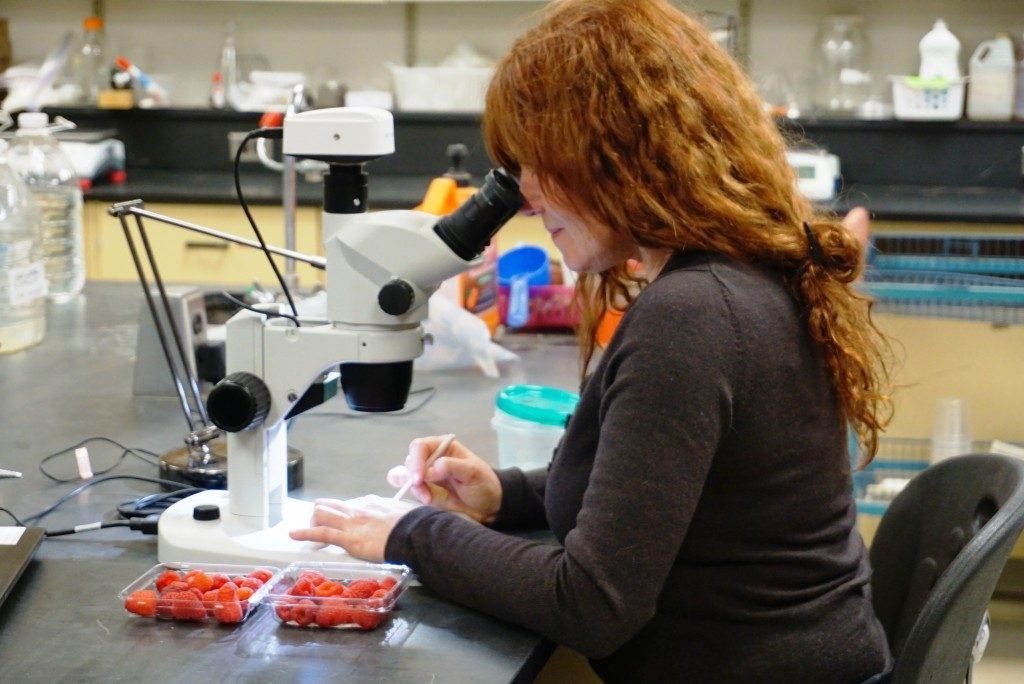
Features
Chemicals
Insects
Keeping an invasive new fruit pest under control
March 1, 2016 By Lilian Schaer / AgInnovation Ontario
 Hannah Fraser in the lab. AgInnovation Ontario.
Hannah Fraser in the lab. AgInnovation Ontario.March 1, 2016 – A new invasive vinegar fly is threatening Ontario’s soft-skinned berry and tender fruit crops. But thanks to the Ontario Farm Innovation Program (OFIP), researchers and farmers are learning more about Spotted Wing Drosophila and how they can keep the pest from destroying their fruit.
Unlike common vinegar flies that are attracted to spoiled fruit, Spotted Wing Drosophila goes after healthy fruit just before harvest. It lays eggs underneath the skin of intact fruit, and as the larvae feed, the fruit tissue breaks down and becomes soft and leaky, resulting in decreased fruit quality and yield.
“Spotted Wing Drosophila has been on the radar in North America since 2010 and it was first identified in Ontario late that year following identification in other provinces and in the United States,” explains Hannah Fraser, horticulture entomology program lead with the Ontario Ministry of Agriculture, Food and Rural Affairs.
“It’s a new pest so we lacked a lot of knowledge on how it behaves in Ontario and how it moves across the landscape,” she adds. “And growers lacked awareness of the pest such as how to manage it and what kind of damage it can do. It takes a long time to learn about a new pest and we collaborate with researchers across Canada, the United States and Europe.”
Fraser and other researchers gathered information on the population dynamics of the fly in Ontario, investigated techniques to track risk and assess management strategies, and developed a platform for timely and efficient communication to growers and consultants.
Baited traps were used to monitor activity in all of Ontario’s major fruit growing areas. Weekly fruit samples were collected at some sites to track infestation levels. Salt tests with ripe fruit were used as a quick method to assess infestation levels at harvest and gauge the effectiveness of pest management strategies.
“The early regions of discovery are in Southwestern Ontario and Niagara, but we have found them as far north as New Liskeard,” says Fraser. “Through weekly blogs and newsletters, we can let growers know when Spotted Wing Drosophila is active and can recommend control measures they can take.”
This includes making changes to crop management, such as tightening of picking schedules, crop sanitation, well-timed insecticide sprays, and better post-harvest handling to preserve fruit quality.
Fraser says although they’re still learning about the pest, the information gathered so far has increased understanding of its behaviour in Ontario and helped growers manage its presence here.
In addition to trapping for adults, fruit should also be sampled at harvest to determine whether the fly is present on-farm and to avoid sending infested fruit to market, and salt water tests will help determine whether changes to sanitation or spraying schedules should be made, Fraser says.
“Because of research we’ve been able to do through this project, growers can strengthen pest management to avoid catastrophic loss and continue to produce great quality berries. If you don’t manage this pest, you can lose your crop,” she adds.
For the Ontario Berry Growers, the OFIP support was invaluable. Research into emerging pests is cost prohibitive for individual growers and allowing the organization to access funds to address this immediate, on-farm research need on behalf of all growers in the province means information can be gathered and shared quickly and effectively.
Print this page